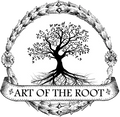The History of Cunning Magic: Origins and Legacy of Low Magic Practices
Have you ever heard of cunning magic? Also known as "low magic," it's a type of folk magic that has been practiced for generations in many regions of Europe. In this blog post, we'll explore the history, methodology, and practiced rituals of this ancient form of magic.
Origins of Cunning Magic: Tracing Back to Pre-Christian Pagan Practices
Cunning magic has its roots in pre-Christian pagan practices in Europe. These practices often revolved around nature and the cycles of the seasons and involved the use of herbs, crystals, and other natural objects to perform spells and rituals. As Christianity spread throughout Europe, many of these pagan practices were absorbed into folk traditions and adapted to incorporate Christian symbols and beliefs.
Cunning Magic in Medieval and Early Modern Europe: A Time of Healing
Cunning magic reached its peak during the medieval and early modern periods when it was widely practiced throughout Europe. During this time, cunning folk were often sought out by their communities for help with a variety of problems, from physical ailments to legal disputes. Cunning folk were most widely known as healers. They used a variety of methods to perform healing rituals, often incorporating elements of herbalism, divination, and prayer.
Methods Used by Cunning Folk to Perform Healing Rituals
Cunning folk were often skilled in the use of herbs and other natural remedies to treat illnesses. They might create poultices, teas, or tinctures from various plants and administer them to the patient. Some cunning folk would also prescribe specific diets or lifestyle changes to promote healing.
Many cunning folk incorporated elements of Christian or other religious traditions into their healing practices. They might say prayers or perform rituals to invoke the aid of specific saints or deities or to ask for divine intervention in the healing process.
Cunning folk might use divination techniques, such as interpreting dreams, to gain insight into the underlying causes of an illness. This information could then be used to develop a treatment plan.
Cunning folk were known for creating and using charms and amulets to protect against illness or to promote healing. These might be worn by the patient, hung above their bed, or placed in a specific location in the home.
Some cunning folk were known for their ability to channel healing energy through the laying on of hands. This practice involves placing the hands on or near the patient's body and using intention and visualization to promote healing.
The Decline of Cunning Magic: From Accusations of Fraud to a Shift in Beliefs
As education and organized religion became more widespread in Europe, the practice of cunning magic began to decline. Many cunning folk were accused of fraud and charlatanism, and their practices were increasingly viewed as superstitious and unscientific. The rise of scientific medicine also played a role in the decline of cunning magic, as people began to turn to doctors for help with medical problems.
The Legacy of Cunning Magic
Despite its decline, some aspects of cunning magic have survived to the present day. Folk traditions and beliefs continue to be passed down through generations, and some people still turn to cunning folk for help with problems that are not easily solved through conventional means.
Cunning Magic Today
Cunning magic has a long and fascinating history in Europe. From its pagan origins to its peak during medieval and early modern Europe, cunning magic has continued to influence folk traditions and beliefs that have survived to the present day. While scientific advancements have played a role in its decline, the power of natural remedies, divination, and prayer still holds a timeless appeal that fascinates and inspires people to this day.





Leave a comment